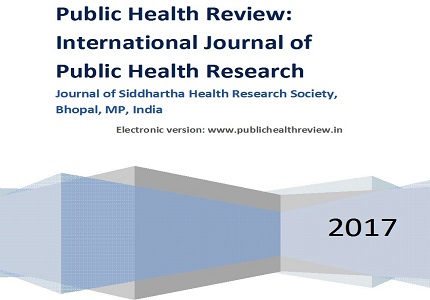Quality of antenatal care provided through the public health sector in a district in North Kerala
Abstract
Introduction: Quality of Care, a key element in provision of health care can be assessed by using technical standards defined by health professionals or from client’s perspective. Considering the population in Kerala to have advantage of early and nearly universal antenatal coverage, there is considerable potential for improving the quality of care, based on regular quality assessment.
Objectives: 1.To evaluate observed quality of process of ante-natal care at various levels in the public health sector of Kozhikode district of Kerala. 2. To find out the perception of antenatal women regarding the antenatal care provided.
Methodology: A cross sectional study was conducted in maternal health care institutions at various levels in the public health sector of Kozhikode district, North Kerala. Arbitrarily, 30% of institutions were selected from each stratum. Observed quality of antenatal care was assessed through passive observation of services delivered with help of a checklist. 197 antenatal women were observed. All antenatal women who had come for their re-visit were interviewed for assessing client perspective of quality of care. Hence 93 antenatal women were interviewed excluding those who had come for first visit.
Results: Overall score for attributes of process of antenatal care was observed to be poor. Interpersonal aspects scored better. There was significant difference between different strata (p <0.001), with better scores at Taluk Hospital and Block Primary Health Centre levels and the difference in scores was found to be significant with regards to Diagnostic-techniques, Treatment-aspects, provision-of-Health-Education. An evident disparity was noted between observed and client’s perspective. 92.47% were satisfied with overall care. More than three-fourth were satisfied with time spent with health care provider though most spent only 5–15 minutes.
Conclusion: Quality of antenatal care delivery needs to be improved.
Downloads
References
2. Testa J, Ouedraogo C, Praul A, De Bernis L, Kone B. Determinants of risk factors associated with severe maternal morbidity: application during antenatal consultation. J GynecolObstetBiolReprod (Paris). 2002; 31(1):44-50.
3. Government of India. Report of Working Group on Health of Women and Children for 12th Five Year plan (2012-2017). New Delhi: Planning Commission, 2012.
4. Donabedian A. The seven pillars of quality. Arch Pathol Lab Med. 1990 Nov;114(11):1115-8. [PubMed]
5. Brawley M. The client perspective: What is quality health service? A literature review: Delivery of Improved Services For Health. Kampala, Uganda; 2000.
6. Langer A, Villar J, Romero M, Nigenda G, Piaggio G, Kuchaisit C, Rojas G, Al-Osimi M, Miguel Belizán J, Farnot U, Al-Mazrou Y, Carroli G, Ba'aqeel H, Lumbiganon P, Pinol A, Bergsjö P, Bakketeig L, Garcia J, Berendes H. Are women and providers satisfied with antenatal care? Views on a standard and a simplified, evidence-based model of care in four developing countries. BMC Womens Health. 2002 Jul 19;2(1):7.
7. Government of India, MOHFW. Decline in Rates of Maternal and Infant Mortality [Press Release]. Retrieved from: http://pib.nic.in/newsite/PrintRelease.aspx?relid=103446.
8. International Institute of Population Studies. Fact Sheet: National Family Health Survey-3 Report, India (2005-2006). Mumbai: IIPS; 2007. 765p. Available from: https://dhsprogram.com/pubs/pdf/frind3/frind3-vol1andvol2.pdf
9. Srilatha S, Remadevi S, Leela IAKR, Vijayakumar K. Assessing the Quality of Antenatal Care in Thiruvananthapuram District. A project report. Kerala Rural Project for Local Level Development, Centre for Development Studies. Thiruvananthapuram. January. 2002;39 p. Available from: http://www.cds.ac.in/krpcds/report/Sreelatha.pdf
10. International Institute for Population Sciences (IIPS), 2010. District Level Household and Facility Survey (DLHS-3), 2007-08: India: Kerala: Mumbai: IIPS. Available from: http://rchiips.org/pdf/rch3/report/KL.pdf
11. Pembe AB, Carlstedt A, Urassa DP, Lindmark G, Nystrom L, Darj E. Quality of antenatal care in rural Tanzania: counselling on pregnancy danger signs. BMC Pregnancy and Childbirth. 2010; 10:35.DOI: 10.1186/1471-2393-10-35. Available from: https://bmcpregnancychildbirth.biomedcentral.com/articles/10.1186/1471-2393-10-35.
12. Boller C, Wyss K, Mtasiwa D, Tanner M. Quality and comparison of antenatal care in public and privateproviders in the United Republic of Tanzania. Bull WorldHealth Organ.2003;81(2):116-22. Epub 2003 Mar 25. [PubMed]
13. Gilson L, Magomi M, Mkangaa E. The structural quality of Tanzanian Primary Health Facilities. Bulletin of World Health Organization 1995 ,73(1): 105-14. [PubMed]
14. Joshi C, Torvaldsen S, Hodgson R, Hayen A. Factors associated with the use and quality of antenatal care in Nepal: a population-based study using the demographic and health survey data. BMC Pregnancy and Childbirth. 2014; 14:94. Doi: 10.1186/1471-2393-14-94.
15. Majrooh MA, Hasnain S, Akram J, Siddiqui A, Memon ZA. Coverage and Quality of Antenatal Care Provided at Primary Health Care Facilities in the “Punjab” Province of “Pakistan.” Bhutta ZA, ed. PLoS ONE. 2014;9(11):e113390. doi:10.1371/journal.pone.0113390.
16. Kyei NN, Chansa C, Gabrysch S. Quality of antenatal care in Zambia: a national assessment. BMC Pregnancy Childbirth. 2012 Dec 13;12:151. doi: 10.1186/1471-2393-12-151. [PubMed]
17. Tetui M, Ekirapa EK, Bua J, Mutebi A, Tweheyo R, Waiswa P. Quality of Antenatal careservices in easternUganda: implications for interventions.Pan Afr Med J.2012;13:27. Epub 2012 Oct 9. [PubMed]
18. Sharma JK, Narang R. Quality of Healthcare Services in Rural India: The User Perspective. VIKALPA.2011;36(1):51-60. Available from: http://journals.sagepub.com/doi/abs/10.1177/0256090920110104.
19. Rani M, Bonu S, Harvey S. Differentials in the quality of antenatal care in India. International Journal for Quality in Health Care. 2008 Feb;20(1):62-71. DOI: 10.1093/intqhc/mzm052. Available from: https://academic.oup.com/intqhc/article/20/1/62/1786297/Differentials-in-the-quality-of-antenatal-care-in
20. Porter M, Macintyre S. What is, must be best: a researchnote on conservative or deferential responses to antenatal care provision. Soc Sci Med. 1984;19(11):1197-200. [PubMed]
21. Habib F, Hanafi MI, El-Sagheer A. Antenatal care in primary health carecentres in Medina, Saudi Arabia, 2009: a cross-sectional study. East MediterrHealth J. 2011 Mar;17(3):196-202.

Copyright (c) 2017 Author (s). Published by Siddharth Health Research and Social Welfare Society

This work is licensed under a Creative Commons Attribution 4.0 International License.


 OAI - Open Archives Initiative
OAI - Open Archives Initiative


